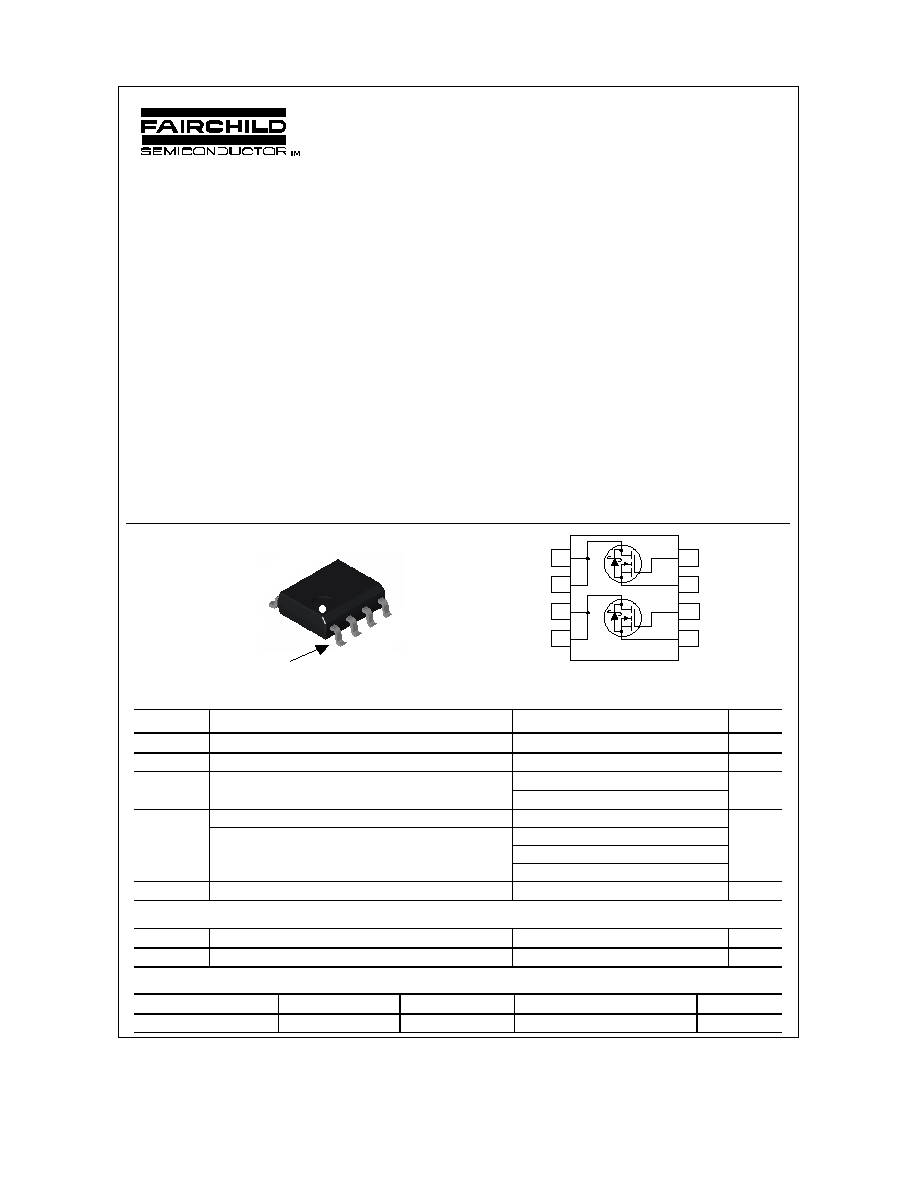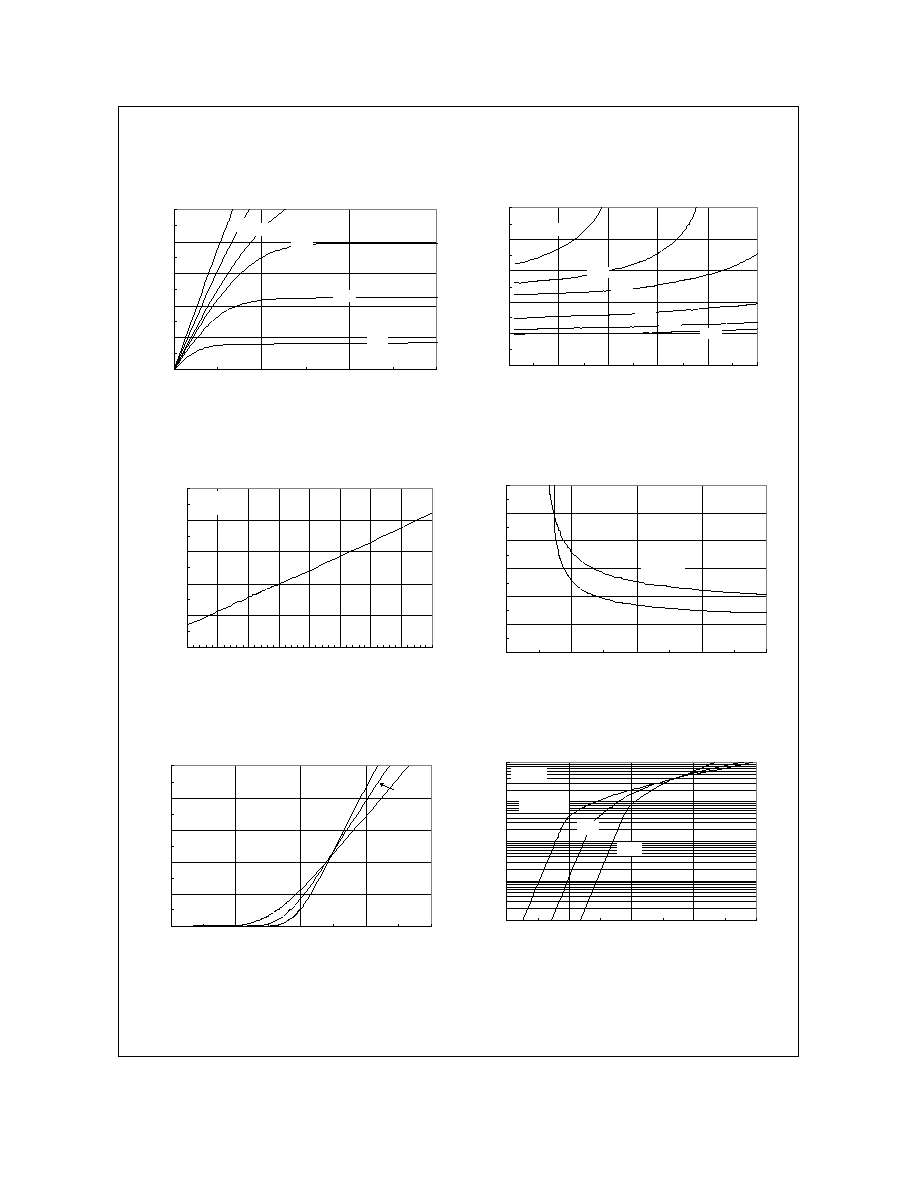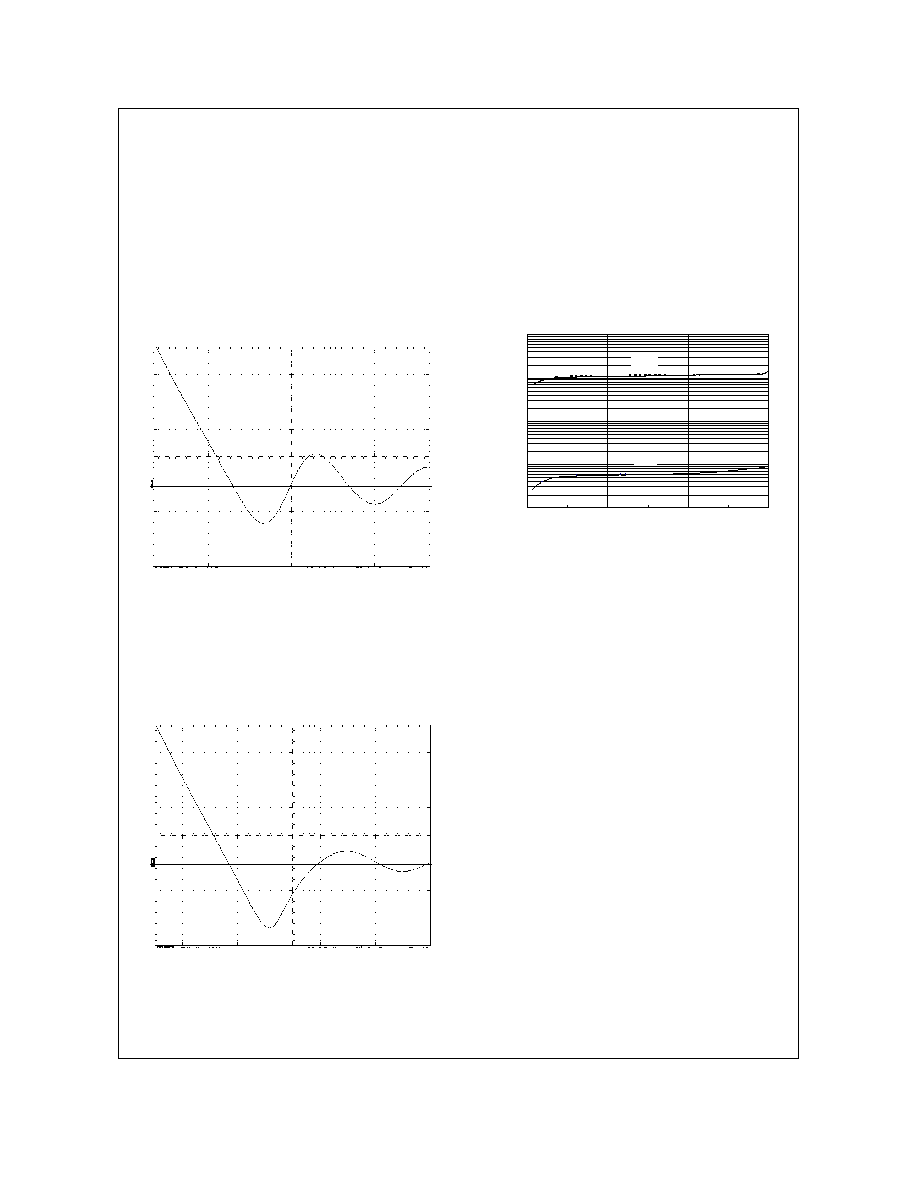 | –≠–ª–µ–∫—Ç—Ä–æ–Ω–Ω—ã–π –∫–æ–º–ø–æ–Ω–µ–Ω—Ç: FDS6990S | –°–∫–∞—á–∞—Ç—å:  PDF PDF  ZIP ZIP |

May 2001
©
2001 Fairchild Semiconductor Corporation
FDS6990S Rev B(W)
FDS6990S
Dual 30V N-Channel PowerTrench
Æ
SyncFET
TM
General Description
The FDS6990S is designed to replace a dual SO-8
MOSFET and two Schottky diodes in synchronous
DC:DC power supplies. This 30V MOSFET is designed
to maximize power conversion efficiency, providing a
low R
DS(ON)
and low gate charge. Each MOSFET
includes integrated Schottky diodes using Fairchild's
monolithic SyncFET technology. The performance of
the FDS6990S as the low-side switch in a synchronous
rectifier is similar to the performance of the FDS6990A
in parallel with a Schottky diode.
Applications
∑
DC/DC converter
∑
Motor drives
Features
∑
7.5A, 30 V.
R
DS(ON)
= 22 m
@ V
GS
= 10 V
R
DS(ON)
= 30 m
@ V
GS
= 4.5 V
∑
Includes SyncFET Schottky diode
∑
Low gate charge (11 nC typical)
∑
High performance trench technology for extremely low
R
DS(ON)
∑
High power and current handling capability
S
D
S
S
SO-8
D
D
D
G
D2
D2
D1
D1
S2
G2
S1
G1
Pin 1
SO-8
4
5
3
6
2
7
1
8
Q1
Q2
Absolute Maximum Ratings
T
A
=25
o
C unless otherwise noted
Symbol
Parameter
Ratings
Units
V
DSS
Drain-Source Voltage
30
V
V
GSS
Gate-Source Voltage
±
20
V
I
D
Drain Current ≠ Continuous
(Note 1a)
7.5
A
≠ Pulsed
20
P
D
Power Dissipation for Dual Operation
2
W
Power Dissipation for Single Operation
(Note 1a)
1.6
(Note 1b)
1
(Note 1c)
0.9
T
J
, T
STG
Operating and Storage Junction Temperature Range
≠55 to +150
∞
C
Thermal Characteristics
R
JA
Thermal Resistance, Junction-to-Ambient
(Note 1a)
78
∞
C/W
R
JC
Thermal Resistance, Junction-to-Case
(Note 1)
40
∞
C/W
Package Marking and Ordering Information
Device Marking
Device
Reel Size
Tape width
Quantity
FDS6990S
FDS6990S
13''
12mm
2500 units
FDS6990S

FDS6990S Rev B (W)
Electrical Characteristics
T
A
= 25∞C unless otherwise noted
Symbol
Parameter
Test Conditions
Min Typ Max Units
Off Characteristics
BV
DSS
Drain≠Source Breakdown Voltage
V
GS
= 0 V, I
D
= 1 mA
30
V
BV
DSS
T
J
Breakdown Voltage Temperature
Coefficient
I
D
= 1 mA, Referenced to 25
∞
C
23
mV/
∞
C
I
DSS
Zero Gate Voltage Drain Current
V
DS
= 24 V,
V
GS
= 0 V
500
µ
A
I
GSSF
Gate≠Body Leakage, Forward
V
GS
= 20 V,
V
DS
= 0 V
100
nA
I
GSSR
Gate≠Body Leakage, Reverse
V
GS
= ≠20 V
V
DS
= 0 V
≠100
nA
On Characteristics
(Note 2)
V
GS(th)
Gate Threshold Voltage
V
DS
= V
GS
, I
D
= 1 mA
1
2.2
3
V
V
GS(th)
T
J
Gate Threshold Voltage
Temperature Coefficient
I
D
= 1 mA, Referenced to 25
∞
C
≠6
mV/
∞
C
R
DS(on)
Static Drain≠Source
On≠Resistance
V
GS
= 10 V, I
D
= 7.5 A
V
GS
= 10 V, I
D
= 7.5 A, T
J
=125
∞
C
V
GS
= 4.5 V, I
D
= 6.5 A
17.5
27
24
22
35
30
m
I
D(on)
On≠State Drain Current
V
GS
= 10 V,
V
DS
= 5 V
20
A
g
FS
Forward Transconductance
V
DS
= 15 V,
I
D
= 10 A
22
S
Dynamic Characteristics
C
iss
Input Capacitance
1233
pF
C
oss
Output Capacitance
344
pF
C
rss
Reverse Transfer Capacitance
V
DS
= 15 V,
V
GS
= 0 V,
f = 1.0 MHz
106
pF
Switching Characteristics
(Note 2)
t
d(on)
Turn≠On Delay Time
8
16
ns
t
r
Turn≠On Rise Time
5
10
ns
t
d(off)
Turn≠Off Delay Time
25
40
ns
t
f
Turn≠Off Fall Time
V
DS
= 15 V,
I
D
= 1 A,
V
GS
= 10 V,
R
GEN
= 6
11
20
ns
Q
g
Total Gate Charge
11
16
nC
Q
gs
Gate≠Source Charge
5
nC
Q
gd
Gate≠Drain Charge
V
DS
= 15 V,
I
D
= 10 A,
V
GS
= 5 V
4
nC
Drain≠Source Diode Characteristics and Maximum Ratings
I
S
Maximum Continuous Drain≠Source Diode Forward Current
2.9
A
V
SD
Drain≠Source Diode Forward
Voltage
V
GS
= 0 V, I
S
= 2.9 A
(Note 2)
0.5
0.7
V
t
rr
Diode Reverse Recovery Time
17
nS
Q
rr
Diode Reverse Recovery Charge
I
F
= 10A
d
iF
/d
t
= 300 A/µs
(Note 3)
12.5
nC
Notes:
1. R
JA
is the sum of the junction-to-case and case-to-ambient thermal resistance where the case thermal reference is defined as the solder mounting surface of
the drain pins. R
JC
is guaranteed by design while R
CA
is determined by the user's board design.
a)
78∞C/W when
mounted on a
0.5in
2
pad of 2
oz copper
b)
125∞C/W when
mounted on a
0.02 in
2
pad of
2 oz copper
c)
135∞C/W when
mounted on a
minimum pad.
Scale 1 : 1 on letter size paper
2. Pulse Test: Pulse Width < 300
µ
s, Duty Cycle < 2.0%
3. See "SyncFET Schottky body diode characteristics" below.
FDS6990S

FDS6990S Rev B (W)
Typical Characteristics
0
10
20
30
40
50
0
1
2
3
V
DS
, DRAIN-SOURCE VOLTAGE (V)
I
D
, DRAIN CURRENT (A)
5.0V
4.5V
4.0V
3.5V
V
GS
= 10V
6.0V
Figure 1. On-Region Characteristics.
Figure 2. On-Resistance Variation with
Drain Current and Gate Voltage.
0.4
0.7
1
1.3
1.6
1.9
-50
-25
0
25
50
75
100
125
150
T
J
, JUNCTION TEMPERATURE (
o
C)
R
DS(ON)
, NORMALIZED
DRAIN-SOURCE ON-RESISTANCE
I
D
= 7.5A
V
GS
= 10V
0
0.01
0.02
0.03
0.04
0.05
0.06
2
4
6
8
10
V
GS
, GATE TO SOURCE VOLTAGE (V)
R
DS(ON)
, ON-RESISTANCE (OHM)
I
D
= 3.8A
T
A
= 125
o
C
T
A
= 25
o
C
Figure 3. On-Resistance Variation with
Temperature.
Figure 4. On-Resistance Variation with
Gate-to-Source Voltage.
0
10
20
30
40
50
1.5
2.5
3.5
4.5
5.5
V
GS
, GATE TO SOURCE VOLTAGE (V)
I
D
, DRAIN CURRENT (A)
T
A
= -55
o
C
25
o
C
125
o
C
V
DS
= 5V
Figure 5. Transfer Characteristics.
Figure 6. Body Diode Forward Voltage Variation
with Source Current and Temperature.
FDS6990S
0.6
1
1.4
1.8
2.2
2.6
0
10
20
30
40
50
I
D
, DRAIN CURRENT (A)
R
DS(ON)
, NORMALIZED
DRAIN-SOURCE ON-RESISTANCE
V
GS
= 4.0V
6.0V
8.0V
10V
5.0V
4.5V
0.001
0.01
0.1
1
10
0
0.2
0.4
0.6
0.8
V
SD
, BODY DIODE FORWARD VOLTAGE (V)
I
S
, REVERSE DRAIN CURRENT (A)
T
A
= 125
o
C
25
o
C
-55
o
C
V
GS
= 0V

FDS6990S Rev B (W)
Typical Characteristics
0
2
4
6
8
10
0
3
6
9
12
15
18
21
Q
g
, GATE CHARGE (nC)
V
GS
, GATE-SOURCE VOLTAGE (V)
I
D
= 10A
V
DS
= 5V
15V
10V
Figure 7. Gate Charge Characteristics.
Figure 8. Capacitance Characteristics.
0.01
0.1
1
10
100
0.1
1
10
100
V
DS
, DRAIN-SOURCE VOLTAGE (V)
I
D
, DRAIN CURRENT (A)
DC
10s
1s
100ms
100
µ
s
R
DS(ON)
LIMIT
V
GS
= 10V
SINGLE PULSE
R
JA
= 135
o
C/W
T
A
= 25
o
C
10ms
1ms
Figure 9. Maximum Safe Operating Area.
Figure 10. Single Pulse Maximum
Power Dissipation.
Figure 11. Transient Thermal Response Curve.
Thermal characterization performed using the conditions described in Note 1c.
Transient thermal response will change depending on the circuit board design.
FDS6990S
0
400
800
1200
1600
2000
0
5
10
15
20
25
30
V
D S
, DRAIN TO SOURCE VOLTAGE (V)
CAPACITANCE (pF)
C
ISS
C
RSS
C
OSS
f = 1MHz
V
GS
= 0 V
0
10
20
30
40
50
0.001
0.01
0.1
1
10
100
1000
t
1
, TIME (sec)
P(pk), PEAK TRANSIENT POWER (W)
SINGLE PULSE
R
JA
= 135∞C/W
T
A
= 25∞C
0.001
0.01
0.1
1
0.0001
0.001
0.01
0.1
1
10
100
1000
t
1
, TIME (sec)
r(t), NORMALIZED EFFECTIVE
TRANSIENT THERMAL RESISTANCE
R
JA
(t) = r(t) + R
JA
R
JA
= 135 ∞C/W
T
J
- T
A
= P * R
JA
(t)
Duty Cycle, D = t
1
/ t
2
P(pk)
t
1
t
2
SINGLE PULSE
0.01
0.02
0.05
0.1
0.2
D = 0.5

FDS6990S Rev B (W)
Typical Characteristics
(continued)
SyncFET Schottky Body Diode
Characteristics
Fairchild's SyncFET process embeds a Schottky diode
in parallel with PowerTrench MOSFET. This diode
exhibits similar characteristics to a discrete external
Schottky diode in parallel with a MOSFET. Figure 12
shows the reverse recovery characteristic of the
FDS6990S.
Figure 12. FDS6990S SyncFET body
diode reverse recovery characteristic.
For comparison purposes, Figure 13 shows the reverse
recovery characteristics of the body diode of an
equivalent size MOSFET produced without SyncFET
(FDS6990A).
Figure 13. Non-SyncFET (FDS6990A) body
diode reverse recovery characteristic.
Schottky barrier diodes exhibit significant leakage at
high temperature and high reverse voltage. This will
increase the power in the device.
Figure 14. SyncFET body diode reverse
leakage versus drain-source voltage and
temperature.
10ns/div
3A/div
FDS6990S
10ns/div
3A/div
0.00001
0.0001
0.001
0.01
0.1
0
10
20
30
V
DS
, REVERSE VOLTAGE (V)
I
DSS
, REVERSE LEAKAGE CURRENT (A)
125
o
C
25
o
C
0V
0V




